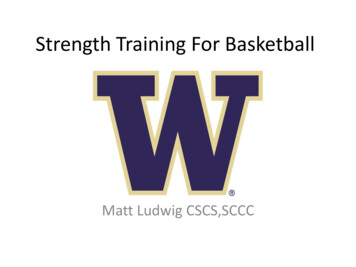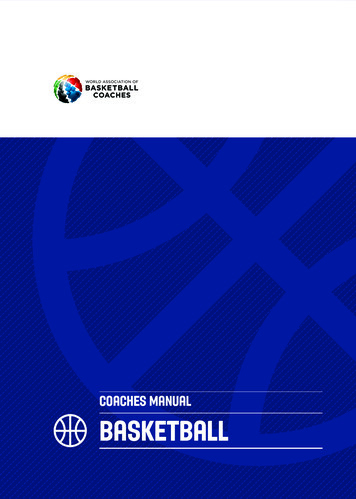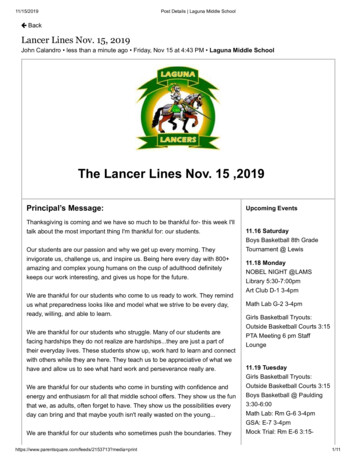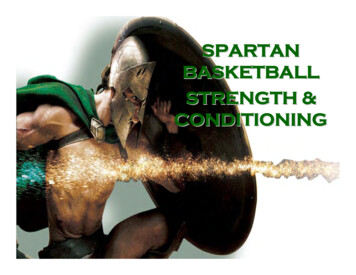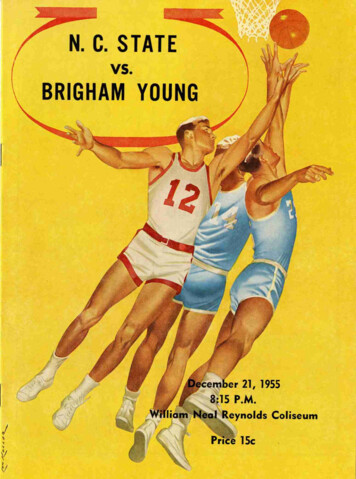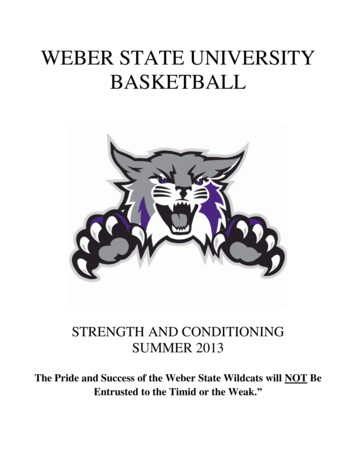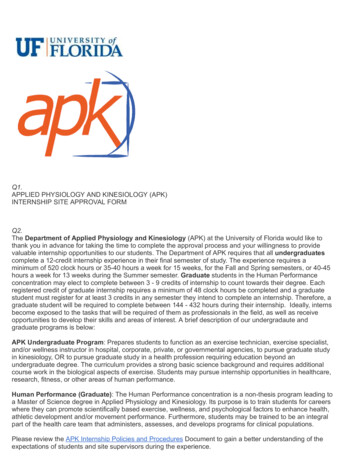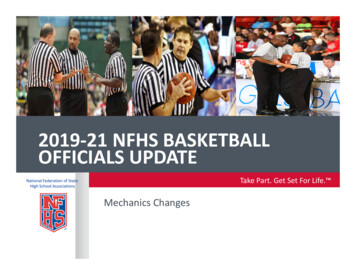
Transcription
2019‐21 NFHS BASKETBALLOFFICIALS UPDATETake Part. Get Set For Life. National Federation of StateHigh School AssociationsMechanics Changes
2019‐21 Basketball Officials Manual UpdateMECHANIC CHANGES
Rule ChangeSTOP CLOCK FOR JUMP/HELD BALL‐PART 3 OF THE NFHS BASKETBALL OFFICIALSMANUAL‐#3 Signal Chart #3When a held ball occurs, thecovering official(s) must stop the clock usingsignal #2 (straight arm, open palm extended)while simultaneously sounding the whistle thengive the held ball signal.www.nfhs.org
Rule ChangeRULE CHANGE 10‐5‐5 NOTEJUMPBALL SIGNAL SEQUENCEStop Clock for Held Ball: In a held‐ball situation, the covering officialshould first blow the whistle while simultaneously using the stop clocksignal (signal 2), and then progress to the held ball signal (signal 3).www.nfhs.org
2019‐21 Basketball Officials ManualTHREE‐PERSON MECHANICS
PRESENTATION TOPICS Part 1 – OfficiatingPrinciples Part 2 – Terminology Part 3 – Signals Part 4 – GameProcedures for a Crewof Two Officials Part 5 – GameProcedures for a Crewof Three Officials
TERMINOLOGY Ball Side: The location of the ball in the normal frontcourtoffensive alignment of a team. In dividing the court downthe middle, (using the basket as a center point), end line toend line. The side of the court where the ball is located isball side. Bump and Run: A technique when one official “bumps”another official out of his/her current position and thevacating official “runs” down into a new position. Center Official: The outside official who is in the off‐ballposition, midway between a step below the free‐throw lineextended and the top of the circle. The Center official maybe table side or opposite side.www.nfhs.org
TERMINOLOGY Close Down: Movement of an official (a step or two)related to movement of the ball. The Trail and Centerclose down toward the end line; the Lead closes downtoward the nearest lane line extended. Lead Official: The official positioned along and off theend line. The Lead official may be table side oropposite the table, but will be on the same side of thecourt as the Trail. Move to Improve: A technique that means to “moveyour feet” in order to “improve your angle” on theplay. Helps to eliminate being “straight‐lined.”www.nfhs.org
TERMINOLOGY Opposite Side: The side of court opposite the tableside. Primary Coverage Area (PCA): Area of responsibilityfor each official. PCA is determined by ball location. Rotation: A live‐ball situation, whereby the location ofthe ball keys a change in coverage for the officials. Thisis implemented when the Lead official moves to ballside dictating a change of position by the Center andTrail officials. The Lead should not rotate until all threeofficials are in the frontcourt.www.nfhs.org
TERMINOLOGY Straight‐Line: Refers to a situation that occurs whenan official allows his/her vision to be obstructed by aplayer or players; having to look through a playerinstead of in between players. When a straight‐lineoccurs, the official is not able to accurately see playingaction. The situation is also known as getting“stacked.” Strong Side: Side of the court determined by thelocation of Lead official.www.nfhs.org
TERMINOLOGY Switch: A dead‐ball situation created by an official whocalls a violation or foul. After a violation is called or a foulis reported to the table, there may be a change in positionof the officials. The switch will normally involve the callingofficial moving to a new position on the court. Table Side: The side of the court where the scorer’s andtimer’s table is located. Trail Official: The outside official positioned nearest thedivision line, approximately 28 feet from the end line(near the top of the three‐point arc). The Trail official maybe table side or opposite side, but will be on the same sideof the court as the Lead. 11
TERMINOLOGY Weak Side: The side of the court opposite theLead official; the Center’s side of the court. Wide Triangle: All three officials forming thegeometric shape of a wide triangle; keeping allplayers and activity within the triangle. 12
PREGAME POSITIONSU1 observes home team warm‐upU2 observes visiting team warm‐up 13
JUMP BALLU1 chops clock –watches jumpersU2 watches eightnon‐jumpersU1 & U2 mindful ofquick 3‐pt attemptand over/back 14
JUMP BALLBall goes leftBall goes rightR (tossing official) alwaysgoes into T position 15
PRIMARY COVERAGE AREASBoth C and T should close down on shots 16
LINE COVERAGEL has entire end lineC has closest sidelineT has closest sideline,division line, and far endlineCall only your line 17
INBOUNDS COVERAGE 18
COVERAGE IN TRANSITION 19
PRESS COVERAGEC stays inbackcourtL should havedeepestplayer infront andboxed‐in 20
SHOT & REBOUND COVERAGEL should not bepositioned withinlane linesBoth C and T shouldclose down on shotsC is primarilyresponsible for weakside rebounding 21
SHOT & REBOUND COVERAGE 22
THREE‐POINT SHOT COVERAGEIf both C and T indicatethe 3‐pt attempt, Treferees defense onshooter and stays withshot; C releases andcovers reboundingC/T should mirror theother official’s “good”signal 23
ROTATIONS Rotations should be thoroughly discussedat the pregame conference Ball location keys the need for a rotation The T or C can facilitate a rotation, butONLY the L initiates a rotation A rotation should only take place when allthree officials are in the frontcourt A rotation begins when L moves laterallyand penetrates the key area 24
ROTATIONS Rotation is not complete until L passesbeyond far lane‐line extended L must officiate play in the post – evenwhile moving across the lane If the L begins to rotate and ball is quicklyreversed or a quick shot taken – L does nothave to complete rotation There should rarely be two T’s – there maybe two C’s for brief periods of time 25
ROTATIONS If a trap occurs near the division line on C’sside of court, C moves higher to officiatethat play and L should initiate a rotation If L does not rotate – C should go back to anormal C position when play permits Remember, only the L initiates a rotation!The C only facilitates the rotation in thiscase. 26
ROTATION SEQUENCEL goes to ball‐side, T closes down, C completes rotation(last to rotate)
TRANSITION AFTER ROTATION All officials must recognize rotation hasoccurred If L rotated late and a transition occurs –it is old L’s (new T’s) responsibility to lookup court making sure partners picked uprotation If not, the new T should be prepared toadjust his/her location on the floor 28
TRANSITION COVERAGE AFTERROTATION 29
THROW‐IN CUES L may administer throw‐ins on either sideof player when staying in frontcourt; Tmirrors clock‐chop signal T handles all throw‐ins in the backcourt –regardless of location – “bump and run” ifnecessary T may bounce any sideline or end linethrow‐in (depends on defensive pressure) 30
END LINE THROW‐INS IN THEFRONTCOURTL may administer throw‐ins on either side of playerwhen staying in frontcourt; T mirrors chop‐clocksignal 31
SIDELINE THROW‐INS IN THEBACKCOURTT handles all throw‐ins in the backcourt –regardless of location – “bump and run” ifnecessary 32
END LINE THROW‐INS IN THEBACKCOURTIf no pressure, C and L may go to home locations 33
FOUL REPORTING 34
FOULS & BASIC SWITCHING Non‐calling officials should observe allplayers Calling official goes table side afterreporting Official originally table side fills thevacancy left by the calling official 35
FOULS & BASIC SWITCHING Third official remains in same positionoccupied at time of foul If calling official was table side, noswitch occurs 36
FOUL REPORTING & SWITCHINGStaying in the FrontcourtLead calls tableside foulgoes to reporting area.Becomes new TT becomes new LC remains C 37
FOUL REPORTING & SWITCHINGStaying in the FrontcourtLead calls foulopposite tablegoes to reportingarea. Thenbecomes new C.C becomes new LT remains T 38
FOUL REPORTING & SWITCHINGON OFFENSIVE CALLSL calls foul opposite,reports and moves tofront court to becomethe new COld T becomesnew LC becomes the new Tand administers thethrow‐in 39 Backcourt to Frontcourt No Free Throws
FOUL REPORTING & SWITCHINGON OFFENSIVE CALLST calls foul opposite,reports and movesopposite to becomenew LOld C becomes new CL goes to sidelineto administerthrow‐in andbecomes new T 40 Backcourt to Frontcourt No Free Throws
FOUL REPORTING & SWITCHINGON OFFENSIVE CALLSC calls tableside , reportsand slides down tobecome new LOld T becomes new CL goes to sidelineto administerthrow‐in andbecomes new T 41 Backcourt to Frontcourt No Free Throws
DISQUALIFICATION PROCEDURE1. New table side (C or T) official: Notifies coach Requests timer to begin 20‐secondreplacement interval Notifies disqualified player2. Officials not administeringdisqualification position forsubsequent throw‐in or free throw 42
DISQUALIFICATION PROCEDURE3. Administering official takes a positionon division line half way betweencenter circle and sideline nearest tableto administer substitution 43
FREE THROWS Calling official becomes T – observes all actionand assists with violations, rebounding actionand fouls L administers all free throws – has responsibilityfor bottom lane space and three spaces on theopposite line C has responsibility for shooter, flight of ball,and top two lane spaces on opposite line C and T close down on last shot attempt 44
FREE THROWS T is at approximately the 28‐foot markand just inside the tableside boundaryline – NOT at the division line L is approximately 4 feet from near laneline for ALL free throws C is halfway between the near lane lineand the sideline; just above the free‐throw line extended 45
FREE THROWSCalling official becomes TL administers all throwsC and T close down on lastshot attempt 46
TIME‐OUTS & INTERMISSIONS Administering official stays with ball atresumption of play location – puts ball onfloor if movement is necessary Positioning of two free officials: 60‐second time‐out/intermission – nearestblock 30‐second time‐out – top of three‐point arc Officials should observe bench and tableactivity 47
TIME‐OUTS & INTERMISSIONS 48
LAST‐SECOND SHOT C or T – Opposite table official isresponsible L may offer assistance or be responsibleon fast break Responsible official communicates withpartners that he/she has the last‐secondshot Discuss during pregame 49
www.nfhs.orgTHANK YOU!
STOP CLOCK FOR JUMP/HELD BALL‐ PART 3 OF THE NFHS BASKETBALL OFFICIALS MANUAL‐#3 Signal Chart #3 When a held ball occurs, the covering official(s) must stop the clock using signal #2 (straight arm, open palm extended) while simultaneo
